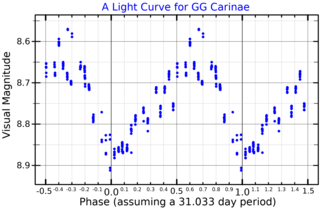
HD 84810, also known as l Carinae, is a star in the southern constellation of Carina. Its apparent magnitude varies from about 3.4 to 4.1, making it readily visible to the naked eye and one of the brightest members of Carina. Based upon parallax measurements, it is approximately 1,600 light-years from Earth.
HD 90853 is a single star in the southern constellation Carina. It has the Bayer designation s Carinae, while HD 98053 is the identifier from the Henry Draper catalogue. This is a variable star with an apparent visual magnitude that ranges from 3.36 down to 3.51, and thus is bright enough to be visible to the naked eye. It is located at a distance of approximately 1,340 light-years from the Sun based on parallax, and has an absolute magnitude of −4.44. The star is drifting further away with a radial velocity of +9 km/s.

V382 Carinae, also known as x Carinae, is a yellow hypergiant in the constellation Carina. It is a G-type star with a mean apparent magnitude of +3.93, and a variable star of low amplitude.

V533 Carinae is a A-type supergiant and a Alpha Cygni variable star with a mean apparent magnitude of +4.59 in the constellation Carina. Located at a distance of about 13,000 light years, it is one of the most distant stars visible to the naked eye.

HR Carinae is a luminous blue variable star located in the constellation Carina. It is surrounded by a vast nebula of ejected nuclear-processed material because this star has a multiple shell expanding atmosphere. This star is among the most luminous stars in the Milky Way. It has very broad emission wings on the Balmer lines, reminiscent from the broad lines observed in the spectra of O and Wolf–Rayet stars. A distance of 5 kpc and a bolometric magnitude of -9.4 put HR Car among the most luminous stars of the galaxy.

NO Aurigae is a pulsating variable star in the constellation Auriga. It is an unusually-luminous asymptotic giant branch star about 3,500 light years away.

V4381 Sagittarii is a variable star in the constellation Sagittarius. A white supergiant of spectral type A2/A3Iab, it is an Alpha Cygni variable that varies between apparent photographic magnitudes 6.57 and 6.62. Its visual apparent magnitude is about 6.54.

HD 33579 is a white/yellow hypergiant and one of the brightest stars in the Large Magellanic Cloud (LMC). It is a suspected variable star.

RT Carinae, also known as CD-58 3538, is a variable star in the Carina Nebula in the constellation Carina. It has a mean apparent magnitude of +8.55.

V1073 Scorpii is a variable star in the constellation Scorpius. It has a non-Greek Bayer designation of k Scorpii. The star has a blue-white hue and is visible to the naked eye with an apparent visual magnitude that fluctuates around +4.87. Parallax measurements yield a distance estimate of approximately 2,920 ly (896 pc) from the Sun, and it is drifting further away with a radial velocity of +7 km/s. It has an absolute magnitude of −6.8

10 Persei is a blue supergiant star in the constellation Perseus. Its apparent magnitude is 6.26 although it is slightly variable.

T Persei is a red supergiant located in the constellation Perseus. It varies in brightness between magnitudes 8.3 and 9.7 and is considered to be a member of the Double Cluster.

V520 Persei is a blue supergiant member of NGC 869, one of the Perseus Double Cluster open clusters. It is an irregular variable star. At a magnitude of 6.55, V520 Persei is the brightest member in either NGC 869 or NGC 884, although the brighter HD 13994 lies in the foreground along the same line of sight.

V915 Scorpii is an orange hypergiant variable star in the constellation Scorpius.

U Lacertae is a spectroscopic binary star in the constellation Lacerta.

V528 Carinae is a variable star in the constellation Carina.

BO Carinae, also known as HD 93420, is an irregular variable star in the constellation Carina.

DU Crucis is a red supergiant and slow irregular variable star in the open cluster NGC 4755, which is also known as the Kappa (κ) Crucis Cluster or Jewel Box Cluster.

GG Carinae is a binary star system in the southern constellation of Carina, abbreviated GG Car. It is a variable star with a brightness that fluctuates around an apparent visual magnitude of 8.67, making it too faint to be visible to the naked eye. The distance to this system is approximately 8,000 light years based on parallax measurements.















